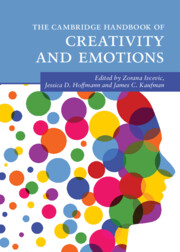Book contents
- The Cambridge Handbook of Creativity and Emotions
- Cambridge Handbooks in Psychology
- The Cambridge Handbook of Creativity and Emotions
- Copyright page
- Dedications
- Contents
- Figures
- Tables
- Contributors
- Acknowledgments
- Creativity and Emotions
- Part I Methods in the Study of Creativity and Emotions
- Part II The Development of Creativity
- Part III Emotions and the Creative Person
- Part IV Emotions and Creative Products
- Part V Emotions and Creativity at School and Work
- 24 Anxiety, Fear of Failure, and Creativity
- 25 Peers, Affect, and Creativity at School
- 26 Creative Curricular Experiences
- 27 Organizational Affective Climate and Creativity at Work
- 28 Group Affect and Creativity
- 29 Psychological Safety and Creativity
- 30 Leadership, Creativity, and Emotions
- 31 A Multilevel Model of Emotions and Creativity in Organizations
- 32 Creativity and Emotion
- Index
- References
31 - A Multilevel Model of Emotions and Creativity in Organizations
from Part V - Emotions and Creativity at School and Work
Published online by Cambridge University Press: 16 February 2023
- The Cambridge Handbook of Creativity and Emotions
- Cambridge Handbooks in Psychology
- The Cambridge Handbook of Creativity and Emotions
- Copyright page
- Dedications
- Contents
- Figures
- Tables
- Contributors
- Acknowledgments
- Creativity and Emotions
- Part I Methods in the Study of Creativity and Emotions
- Part II The Development of Creativity
- Part III Emotions and the Creative Person
- Part IV Emotions and Creative Products
- Part V Emotions and Creativity at School and Work
- 24 Anxiety, Fear of Failure, and Creativity
- 25 Peers, Affect, and Creativity at School
- 26 Creative Curricular Experiences
- 27 Organizational Affective Climate and Creativity at Work
- 28 Group Affect and Creativity
- 29 Psychological Safety and Creativity
- 30 Leadership, Creativity, and Emotions
- 31 A Multilevel Model of Emotions and Creativity in Organizations
- 32 Creativity and Emotion
- Index
- References
Summary
We adopt a multilevel view of emotions and creativity in organizations. Consistent with traditional definitions of the construct, we define creativity broadly in terms of a process that leads to ideas, products, or problem solutions that are both novel and practically useful. More recently, scholars have come to understand that organizational creativity is inherently a multi-level phenomenon that can (1) manifest as a within-person, temporally varying phenomenon, (2) be influenced by employees’ individual proclivities for creative behavior, (3) involve interpersonal communication of ideas, (4) emerge as team or group creativity, or (5) reflect a creative organizational culture or climate. In this chapter, we aim to integrate these creative processes across all five levels of analysis. We especially address circumstances under which creativity can be associated with positive or negative affect, arguing that, depending on personal and situational conditions, creativity can be associated with either positive or negative emotions. We conclude with suggestions for future research.
- Type
- Chapter
- Information
- The Cambridge Handbook of Creativity and Emotions , pp. 598 - 619Publisher: Cambridge University PressPrint publication year: 2023

